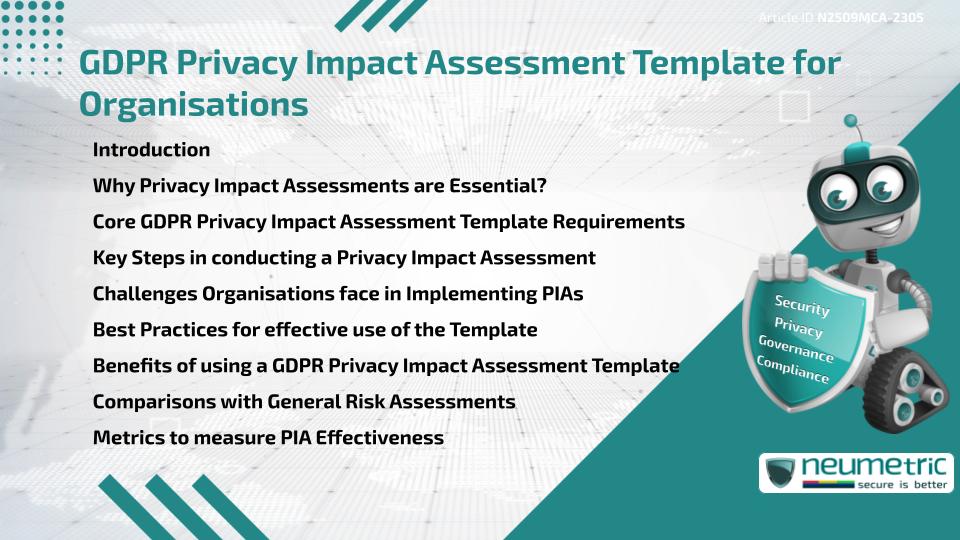Table of Contents
ToggleIntroduction
A GDPR Privacy impact Assessment Template provides Organisations with a structured Framework to evaluate Risks associated with Processing Personal Data. Also known as a Data Protection Impact Assessment [DPIA], this tool is required under the General Data Protection Regulation [GDPR] whenever High-Risk Processing activities are undertaken. By following a Template, Businesses can systematically assess Compliance Risks, implement Safeguards & demonstrate Accountability to Regulators.
Why Privacy Impact Assessments are Essential?
Privacy Impact Assessments [PIAs] are designed to identify & minimise Risks to Individuals’ Personal Data. They are particularly important when Organisations engage in large-scale monitoring, use new Technologies or handle sensitive categories of Data. Without a proper Assessment, Businesses may inadvertently expose themselves to Data Breaches, Non-Compliance Penalties & Reputational damage.
Core GDPR Privacy Impact Assessment Template Requirements
A GDPR Privacy impact Assessment Template typically includes:
- Description of Processing Activities: Scope, purpose & type of data collected.
- Assessment of Necessity & Proportionality: Justifying why the Processing is required.
- Risk Analysis: Identifying Risks to Data Subjects’ Rights & Freedoms.
- Mitigation Measures: Technical & Organisational Safeguards to reduce Risks.
- Consultation Records: Engagement with Stakeholders and, where necessary, Regulators.
- Documentation: Keeping Evidence for Audits & Accountability.
Further detail is provided in the European Data Protection Board guidelines.
Key Steps in conducting a Privacy Impact Assessment
Organisations using a GDPR Privacy impact Assessment Template should:
- Identify Processing activities that require a PIA.
- Describe the Data Flow & Processing purpose in detail.
- Analyse potential Risks & their likelihood.
- Define & implement Safeguards such as Encryption or Anonymisation.
- Consult with Data Protection officers or Regulators where appropriate.
- Document findings & update regularly.
Challenges Organisations face in Implementing PIAs
Key challenges include:
- Difficulty in identifying all High-Risk Processing activities.
- Lack of expertise in Risk Analysis & Data Protection Law.
- Limited Resources for Continuous Monitoring & Updates.
- Resistance from Business units that view PIAs as Administrative burdens.
These barriers can be overcome with Training & use of structured Templates.
Best Practices for effective use of the Template
To make the most of a GDPR Privacy impact Assessment Template, Organisations should:
- Embed PIAs into Project planning from the outset.
- Use cross-functional Teams including IT, Legal & Business units.
- Automate Data Flow mapping where possible.
- Provide training for Staff on completing PIAs effectively.
- Regularly review & update Templates to reflect Regulatory changes.
Useful implementation Resources can be found at ISACA.
Benefits of using a GDPR Privacy Impact Assessment Template
Adopting a structured GDPR Privacy impact Assessment Template delivers:
- Better Risk Management for High-Risk Data Processing activities.
- Stronger Compliance with GDPR & other Privacy Regulations.
- Increased Accountability through documented Evidence.
- Improved trust with Regulators, Customers & Employees.
- Enhanced Organisational resilience against Data Breaches.
Comparisons with General Risk Assessments
While general Risk Assessments focus on operational or Financial Risks, a GDPR Privacy impact Assessment Template is specific to Personal Data Protection. It requires Organisations to consider Individuals’ Rights & Freedoms as a primary factor. This makes PIAs both narrower in Scope & more directly linked to Regulatory Compliance.
Metrics to measure PIA Effectiveness
To measure the impact of PIAs, Organisations should track:
- Number of High-Risk processes assessed annually.
- Percentage of PIAs completed before project launch.
- Reduction in identified Risks after Mitigation measures.
- Regulator or Auditor feedback on completed PIAs.
- Frequency of PIA reviews & updates.
Takeaways
- Provides a structured Framework for GDPR-mandated Privacy Impact Assessments
- Helps identify high-Risk Processing activities & associated Threats
- Strengthens Compliance with GDPR Accountability obligations
- Protects Individuals’ Rights & Freedoms by reducing Risks
- Enhances trust with Regulators, Employees & Customers
- Streamlines Documentation for Audits & Governance oversight
- Encourages collaboration between HR, IT, Legal & Business Teams
FAQ
What is a GDPR Privacy impact Assessment Template?
It is a structured tool that helps Organisations evaluate Data Protection Risks & Compliance obligations under GDPR.
When is a Privacy Impact Assessment required?
A PIA is mandatory when Processing activities are likely to pose high Risks to Individuals’ Rights & Freedoms.
What should a GDPR PIA include?
It should include descriptions of Processing, Risk analysis, Safeguards, consultation & Documentation.
Can Small Organisations use a PIA Template?
Yes, Templates make it easier for Smaller Organisations to meet GDPR obligations with fewer Resources.
Who is responsible for completing a PIA?
Typically, the Data Protection Officer [DPO] coordinates the PIA with input from relevant Business units.
How often should PIAs be updated?
They should be updated whenever significant changes in Processing activities or Technologies occur.
Are PIAs only required under GDPR?
No, other Privacy Regulations also recommend or mandate similar Assessments, though GDPR is more explicit.
Need help for Security, Privacy, Governance & VAPT?
Neumetric provides organisations the necessary help to achieve their Cybersecurity, Compliance, Governance, Privacy, Certifications & Pentesting needs.
Organisations & Businesses, specifically those which provide SaaS & AI Solutions in the Fintech, BFSI & other regulated sectors, usually need a Cybersecurity Partner for meeting & maintaining the ongoing Security & Privacy needs & requirements of their Enterprise Clients & Privacy conscious Customers.
SOC 2, ISO 27001, ISO 42001, NIST, HIPAA, HECVAT, EU GDPR are some of the Frameworks that are served by Fusion – a SaaS, multimodular, multitenant, centralised, automated, Cybersecurity & Compliance Management system.
Neumetric also provides Expert Services for technical security which covers VAPT for Web Applications, APIs, iOS & Android Mobile Apps, Security Testing for AWS & other Cloud Environments & Cloud Infrastructure & other similar scopes.
Reach out to us by Email or filling out the Contact Form…


